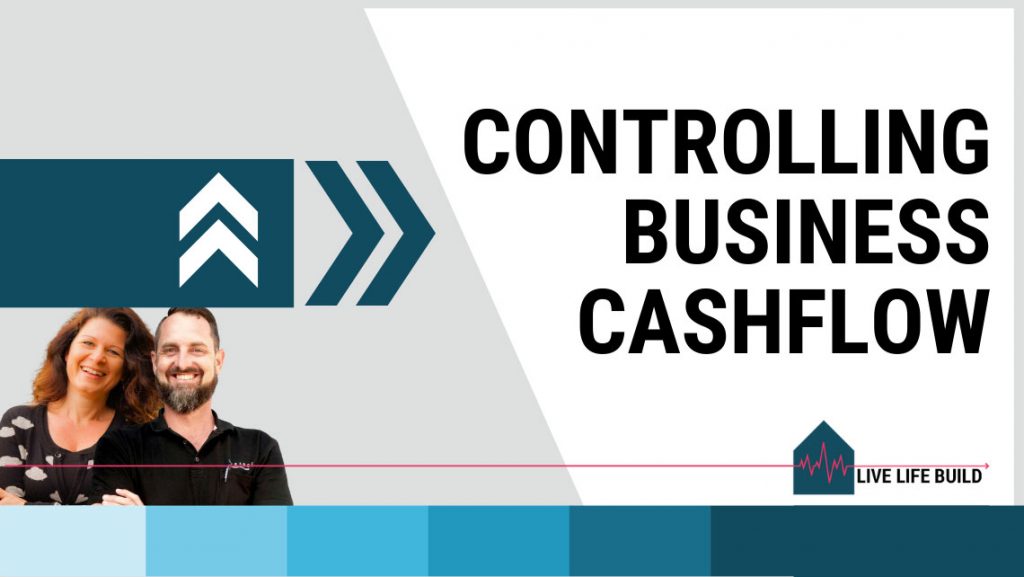Do you know if your business cashflow is in trouble?
Are you as profitable as you think you are?
In this blog, we take you through the 5, 4, 3, 2, 1 of how to be in control of your business cashflow, which is the only way to know if you’re truly doing well as a building business.
As we come up to the end of any financial year, accountants around the country (and around the world) will be reviewing builders’ financial books and getting them ready for tax time.
And often what happens is this conversation: “Wow, you’ve had a great year. Look at all this profit in your books. You should go invest in that car / tool / insert-other-tax-write-off before the end of the financial year.”
Unfortunately, far too many builders will follow this advice. Despite sensing on some level that their cash position isn’t anywhere as flush as their on-the-books position. Or perhaps in a state of ignorant bliss that they’ve actually had a better year financially than they really have.
Far too many builders are unknowingly going out the back door. This happens often through a lack of management of their own cashflow, and a lack of understanding of what their business actually costs to run.
As a builder, your business success lives and dies in your ability to manage your business cashflow.
With such huge sums arriving and exiting your account on a regular basis, it’s essential that you understand how to manage and control your business cashflow properly.
Want some help in how to be in control of your business cashflow?
Check out our 5, 4, 3, 2, 1 of our 6P Methodology PROFESSIONAL: How to be in control of your business cashflow.
5. TURNOVER VS PROFIT: WHAT ARE YOU CHASING?
You don’t have to spend long in this industry before you start to hear builders spruiking the size of their turnover.
The pin-up builders are often celebrating their multi-million dollar revenues, and held up as sources of inspiration and aspiration to others in the industry, who aim to have businesses like them.
But do you know how profitable those businesses truly are?
Because it is possible to be making A LOT of revenue, and absolutely no profit.
If you’re chasing big goals around your business revenue, but you have no idea how much profit you’re making, you may end up simply creating a much bigger machine to feed. And a much bigger headache for yourself, where the risks are far more significant, and dangerous for anything you have tied up in your business (like your family home).
So do you know your numbers? Do you do post-project audits to assess whether you were actually profitable, after all costs and overheads were considered?
We find when we work with builders to help identify their true profit, it’s a rude and confronting shock at first. Because they often find they’ve actually been simply covering their costs. There’s no profit involved, let alone the profit margin they’ve been targeting.
Get to know your numbers. Determine a target profit margin, and compare your true performance to it. The knowledge can be really powerful in turning around a poor performing building business.

4. PAY YOURSELF AN ACTUAL WAGE
As a builder and owner of your business, do you pay yourself a wage?
If your wife or partner works in the business too, do they get paid a suitable wage as well?
One of the most dangerous things you can do in any business, but especially a building business, is treat the business accounts as your personal life slush fund. Rather than paying themselves a wage, many builders will simply draw cash out of their business accounts as they need it.
There are also many building businesses where the builder’s wife is working in the business for free. She may be working after hours, around her own job, the kids and other commitments, however her work is still essential to the business operations. And yet she’s not drawing a wage, and is not recognised as a cost to the business at all.
If your building business is reliant on free labour in order for it to operate, it is not a viable business.
If this is you, it’s essential that you:
- identify a salary for yourself as the business owner
- Identify a salary for your partner or wife working in the business
- Factor those figures into your project proposal or business costs so you can understand your markups more accurately (see point number 3 next about overheads for more information)
We can’t emphasise this enough. Pay yourself a wage. Be realistic with what you should be earning from your business. Otherwise you’ve simply bought yourself a really badly paying job and a whole lot of risk as well.

3. UNDERSTAND YOUR OVERHEADS SO YOU CAN BE ACCURATE WITH YOUR MARGIN
Please sit down and go through your overheads and identify what they are. ALL OF THEM.
Many builders don’t have a good handle on their overheads, and are pretty much plucking a figure out of the air (or setting it according to what they think architects, designers or homeowners will tolerate).
A figure of 10% is often thrown about as an ‘appropriate’ overhead margin to include in contracts.
Recently, we took our Live Life Build members through an exercise to calculate all their business overheads, and identify what that will mean as a margin in their business, as well as a markup to add to future proposals.
This exercise never ceases to surprise (and shock) some. Because it is rarely 10%. And remember – this is only identifying overheads. It does not include a profit margin.
Since then, we’ve been collecting information from builders about their revenue and overheads to help them make the calculations for their overhead markups and margins.
Builders with revenues between $1.4M and $4.0M have been sharing their details with us.
Guess what? Overheads are not 10%. They have been ranging between 14% and 16%.
If you don’t know what your overhead margin should actually be to cover your business running costs, you’re in more trouble than you realise.
Your overheads can include (but aren’t limited to):
- rent
- office utilities (elec, phone, mobiles etc)
- marketing and web hosting
- staff costs not directly on projects
- tools and equipment
- maintenance of those tools etc
- insurances
- accounting and book-keeping
- staff training
- legal fees
- software and subscriptions
- membership fees
- donations
- entertainment costs (xmas parties etc)
- workcover
- licenses and permits
- clothing and other equipment
- parking and tolls
- vehicle costs, registration, leases
- stationery and postage
NOTE: as the business owner, if you don’t spend all your time on projects, your overheads will also include a percentage of your income for the time you spend on general business admin
And if your partner is working in the business – even if you’re not physically paying them a wage right now – factor in the cost of their salary as an overhead so it’s included in your project proposals.
We did this recently with one of our members and found that, once we assumed a salary for the wife who was not being paid, their overheads percentage went from 12% to 14%. This meant their markup on projects to cover overheads went from 14% to 19%.
That’s a big difference.
If you’re losing 5% on every job, because you’re relying on a family member to work for free, you’ll never grow a sustainable building business.

2. WHERE DOES THE MONEY GO? ALLOCATE YOUR FUNDS BEFORE YOU SPEND THEM.
It can be challenging as a builder to navigate the financial side of your business.
Understanding cash in and cash out is straight forward. However, when you take into consideration the delays on payments, what it can look like on paper and in your accounting software, and the management of tax obligations as well, it can get confusing.
Even in small building businesses, you’re often handling large sums of money as a business owner, as it flows from the client into your account, and then back out again as you pay suppliers and sub-contractors.
We’ve all seen builders manage this poorly, and they end up forward charging for work on projects, or constantly chasing the next job, to pay for the poor cashflow on the previous one.
There’s a few things to consider in this regard.
Firstly, you could consider setting up a range of accounts to assist with distributing and protecting the funds that are paid into your business.
It’s human nature to spend what you see if it’s all left in the same account.
Profit First can be a good strategy to use to allocate funds to various accounts to cover the ‘buckets’ of money needed in your business. You can tailor these to your own needs and determine appropriate percentages for distribution each time an invoice is paid.
It can be a great way to protect your profit and own wage, whilst keeping a lid on your business costs and project expenses.
Secondly, consider allocating a percentage of every invoice to a defects or warranty account.
This could be 1% to begin with, and build up further if needed. Basically it provides the funds needed to cover any fulfillment of warranty issues you may experience on your projects long-term – rather than you having to scramble for the cash if and when those situations arise. Worst case scenario, you’re building up a nest egg of funds you’ll have in the future. It’s a good problem to have.
Thirdly, get to know your accounting reports.
Many builders refuse to educate themselves about their own books because they weren’t good at maths at school, and they just want to focus on clients and construction. You can put yourself in a huge position of risk.
We’ve seen scenarios where builders assumed accountants were paying BAS, only to find they have a huge tax bill with interest.
We’ve seen builders spending funds they don’t have on ‘tax-saving’ expenses.
We’ve seen accountants not understand how differently a building business operates from a cashflow and accounting perspective, and do a poor job of running the books.
It’s your business. Get yourself educated about your business’ financial management. Find a good accounting partner, and meet with them regularly.

1. SCHEDULE A REGULAR REVIEW
There’s a saying that goes: “What gets measured gets managed”. This applies very strongly to the measurement and management of your business cashflow.
Make it a weekly diary date to review the cash going in and out of your business. And then keep that date.
Don’t wait till the end of every financial year, or only do it each quarter. You need to understand on a regular basis what is in your bank, what is due to be paid, and what is due to come in.
Doing this with scheduled regularity will make it a much simpler task overall. It’ll also give you the ability to be more proactive in your business.
If you’re working with an external book-keeper or accountant, discuss with them how you can get regular updates. Using cloud based accounting software can be helpful for giving you access to regularly check in.
Having a profitable bottom line on paper is like being rich in Monopoly. It doesn’t pay the mortgage or put food on your family’s table.
Figures on a business balance sheet rarely equal cash at hand in your bank account.
Don’t bury your head in the sand about your business cashflow. Be proactive in managing this in your business, and it will enable you to operate more confidently.
Plus, when the accountant says “hey, go spend that money”, you can actually know if that’s a good idea – or whether it’s sensible to wait instead.
You can be a builder who wasn’t good at maths at school, and still be a savvy business boss and entrepreneur, running a thriving and profitable building operation.
Get yourself informed and educated.
After all, it’s your money.

So, here’s our 5, 4, 3, 2, 1 to identify your ideal project.
5. Have you asked your team what their goals are?
4. How can you help and facilitate your team’s goals?
3. What are your goals as a team?
2. Holding people accountable.
1. Celebrate the wins and create a good work environment.
Live Life Build’s 6P Methodology unlocks the 6 ways to elevate your building business:
PERSONAL | PROJECTS | PEOPLE | PARTNERSHIPS | PROCESSES | PROFESSIONAL
Are you in control of your business cashflow? Or does it control you?

